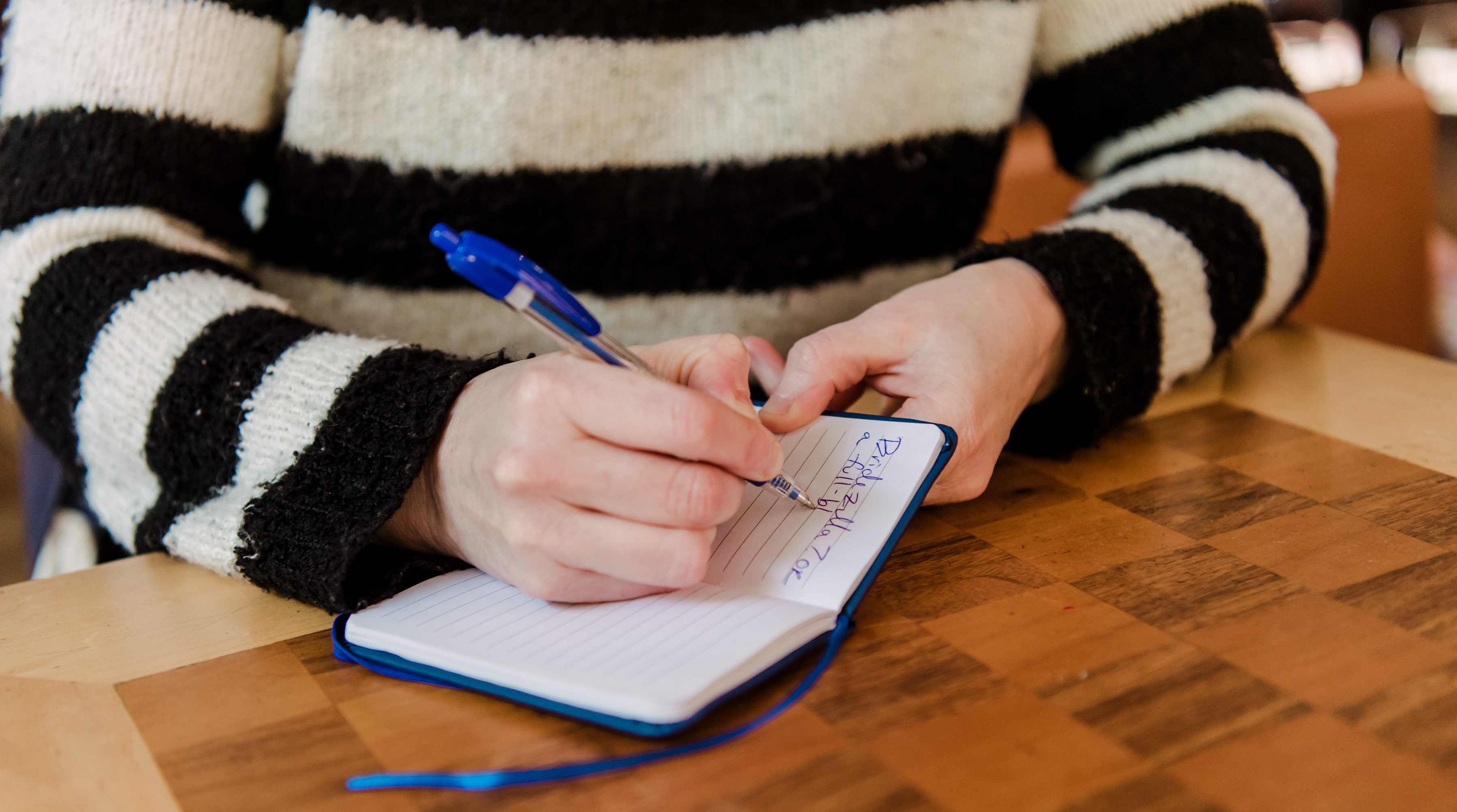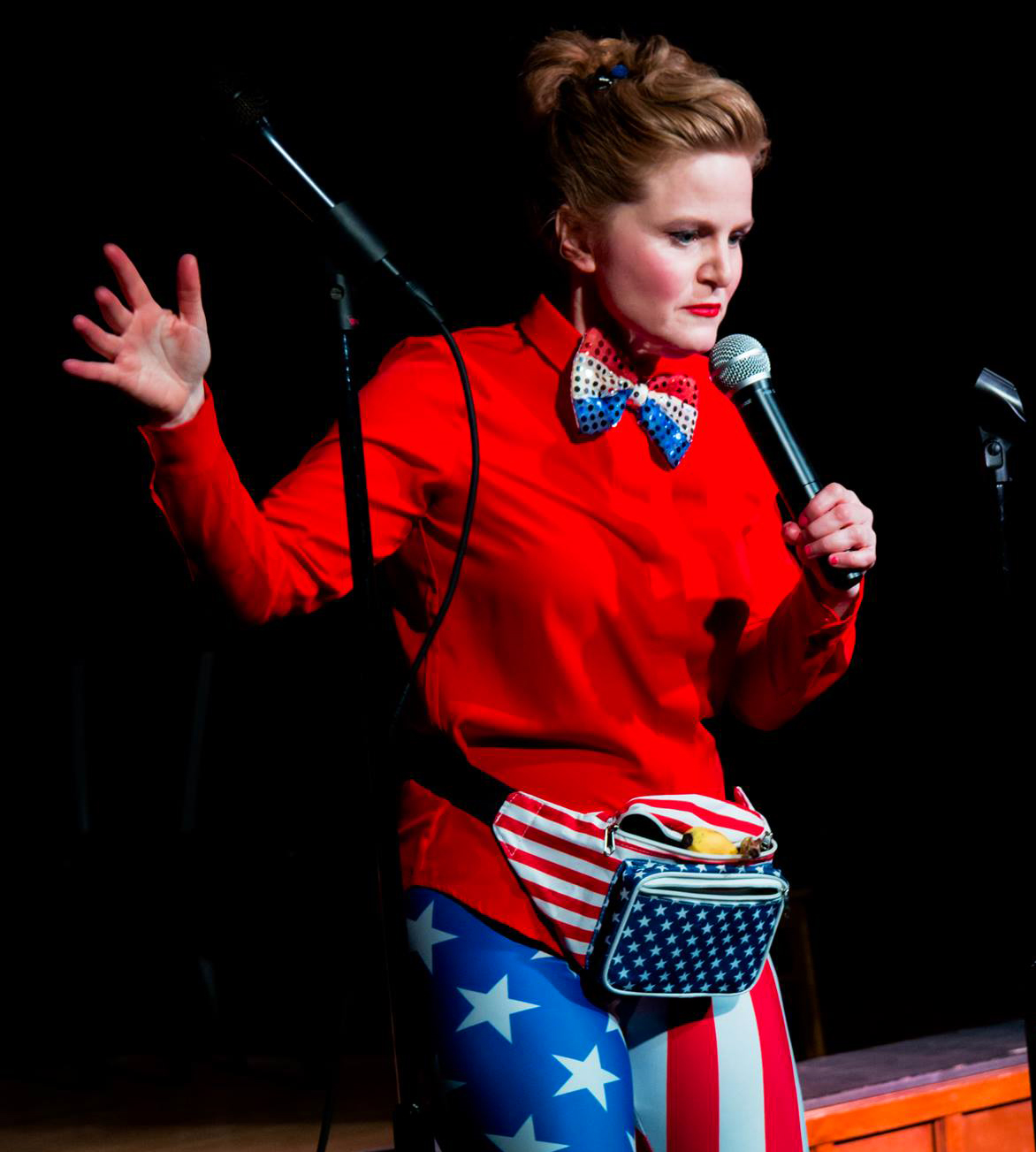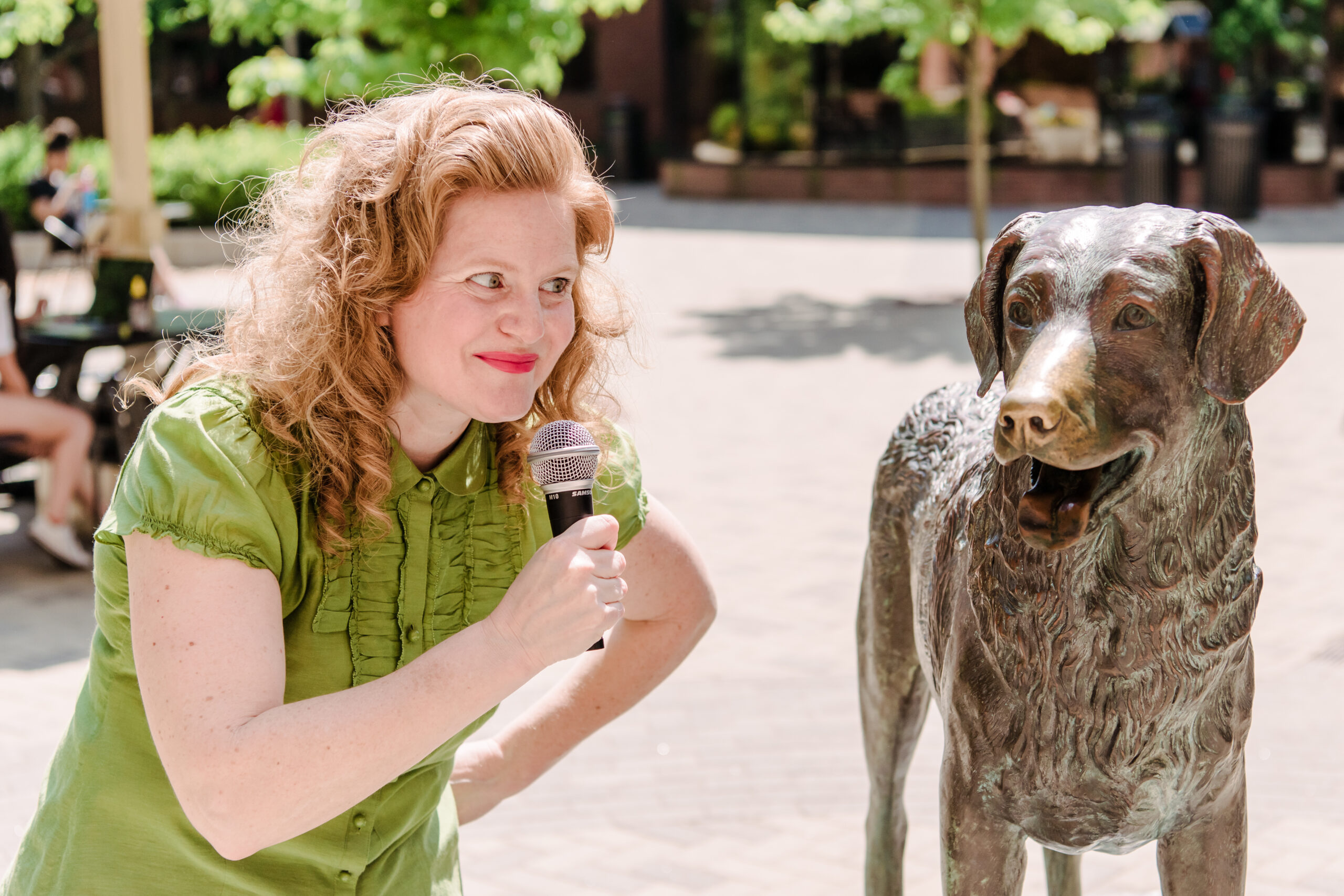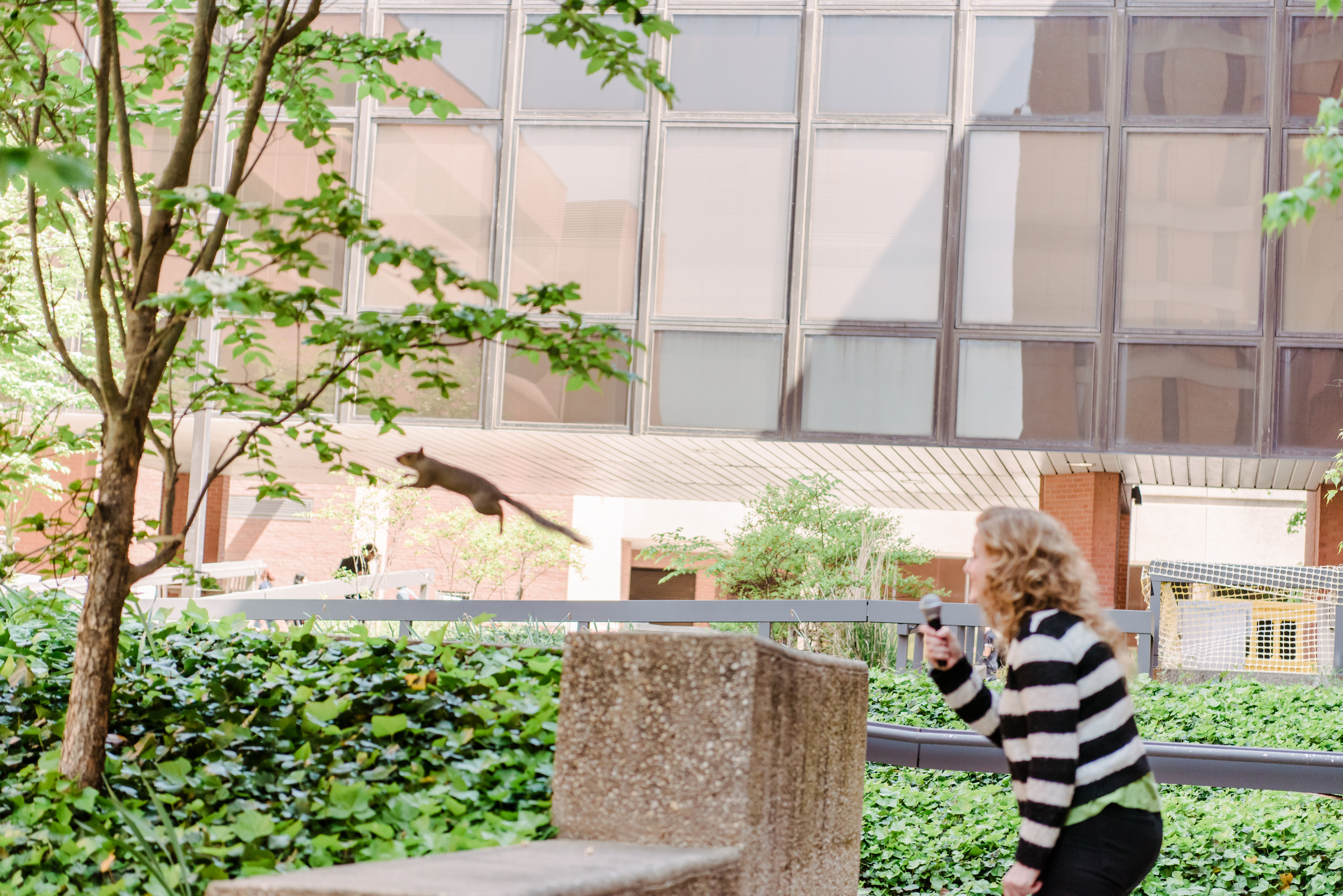We all experience levels of humor in our lives. We may giggle at memes on social media, snarf quietly to ourselves when we spy someone make a goof at work, or fall on the floor laughing at the silly things our children say and do. We have “dad jokes” and “potty humor” readily available to us in books and top 10 lists. We know, innately, what works and what doesn’t, and we react accordingly.
Taking it all up a notch, however, by creating the humor yourself, is another level entirely. And getting up in front of an audience, be it a few friends or a giant concert hall of strangers, to deliver it—well, that takes a certain type of guts this author admittedly does not have. Thankfully, we have Christine Ferrera, M.F.A. ’10, intermedia and digital arts, to help us out. For the last five years, Ferrera—who in addition to working as a video producer at UMBC’s New Media Studio is the author of the Starbux Diary, a collection of witty feedback letters she wrote to corporate coffee—has been hitting open mics and comedy festivals non-stop, learning how to hone her craft one punchline at a time.
Tools of the Trade: + A notebook, always at the ready + A tape recorder for the most honest feedback + Free evenings for hitting the open mics + A healthy attitude toward rejection + The right comedy community for you
STEP 1: Write things down, and don’t censor yourself.
 You never know when an idea will pop into your head, so, you’ve got to be ready when one comes your way. The best way is to always have a notebook on hand. For Ferrera, it’s a small notebook she acquired at the Red Clay Comedy Festival in Atlanta. Inside are tidbits, observations, and scribbles.
You never know when an idea will pop into your head, so, you’ve got to be ready when one comes your way. The best way is to always have a notebook on hand. For Ferrera, it’s a small notebook she acquired at the Red Clay Comedy Festival in Atlanta. Inside are tidbits, observations, and scribbles.
“Some of them are bad or embarrassing, but at this point it doesn’t matter. You never know what will be useful later,” says Ferrera, who keeps the book on her nightstand for midnight musings, and even sometimes asks friends to write ideas down for her in it when she’s driving.
“This isn’t where you’re going to write full jokes. It could be you just thought about something funny, like a phrase or an image or something like that,” she says. “And don’t censor yourself. Later is when you’re going to go in and make something out of it.”
STEP 2: Schedule writing sessions with goals in mind.
Once you have some solid—or vaguely solid—ideas, it’s time to work on writing actual jokes. There are many flavors of comedy out there, and the only way you’ll find yours is to start putting pen to paper.
“I’ll take a notebook and go to a coffee shop and I’ll do a writing session where I’ll set a goal for myself,” says Ferrera. “I’ll say, maybe today I’m going to write three jokes, or five jokes. And then I sit there and pretty much make something out of all those tidbits I’ve been writing down.”
Ferrera also draws inspiration—and discipline—from comedians she admires, like Gary Gulman, who offers a comedy writing tip each day on social media, and recommends setting time aside each day to write.
“I know how valuable that is,” she says. “When I did Starbux, that was 10 years of writing a small amount every day….the writing sessions are kinda torture, but it’s exciting and fun when you really get rolling, just like any creative art form.”
STEP 3: Get yourself up on that stage.

By now you’re probably watching other comics perform fairly often (if not, it’s time to start!), and you’re beginning to make choices about what you might like to do yourself. Just don’t wait too long to jump into performing yourself, says Ferrera, who hits as many open mics as she can.
“So because it’s pretty much universally daunting to most people to, like, get up and try to tell jokes, just get it over with,” says Ferrera. “Don’t write and write and write until you have the perfect set. Throw some stuff together and get up there with a few minutes of something.”
Over time, as you listen to feedback from the audience, polish your jokes and your delivery. Ferrera records herself so she can critique herself later and make changes to her repertoire over time. The ultimate first goal: to have a “tight five,” or five solid no-fail minutes of material in your pocket for anytime you need it. You will probably bomb along the way, she says, but that’s part of learning, too.
“It can be excruciating, but you have to do it. You will sound terrible, and you’ll hear yourself going ‘um, uh,’…but then you’ll quit doing those things,” she says. “The more you perform, you’ll find you do it a little differently, and after a lot of times, you’ll say…‘oh, that really worked!’”
STEP 4: Find your voice.
As you feel more comfortable with the rhythm of your words and performance, the next step is to try to make the comedy your own. We’ve all seen the same jokes rehashed by multiple comics, and we’ve all seen performers who draw from common topics—politics, relationships, etc. So, how do you produce something nobody’s ever seen before?
“What I consider a mistake is when people say, ‘I wanna do comedy,’ and so they’re like ‘Comedy sounds like this. Comedy is talking about dating. Or comedy is making fun of that thing,’” she says. “And that’s so covered already.”
Ferrera likes to draw from her performing arts background, and reminds herself often that her comedy isn’t for everybody. And it doesn’t have to be. Like one of her favorite performers, Maria Bamford, Ferrera wants to stay true to who she is and grow from there.
“Maria Bamford has been out there 30 years sticking to her gut instincts. It’s literally so specific to her, and the way she thinks. That’s what I aspire to,” says Ferrera.
“I would rather bomb or whatever, but be doing stuff that I actually care about saying and doing. Because then, when it’s good, it’s SO good. You can’t beat it.”
*****
All photos by Marlayna Demond ’11, unless otherwise noted.


